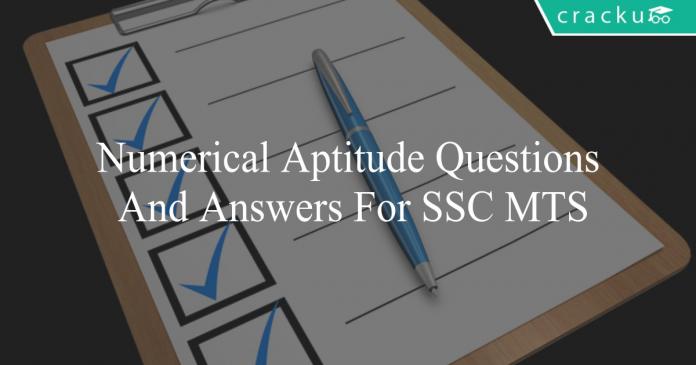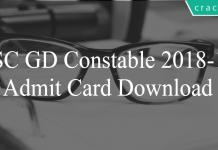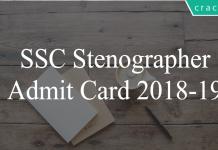Numerical Aptitude Questions And Answers For SSC MTS
Download Top-20 SSC MTS Numerical aptitude Questions PDF. Numerical aptitude questions based on asked questions in previous year exam papers very important for the SSC MTS exam.
Download Numerical Aptitude Questions And Answers For SSC MTS
Take a free mock test for SSC MTS
SSC MTS Previous Papers (Download PDF)
Instructions
One of the numbers in the given series is incorrect. Find the incorrect number in the series
Question 1: 7, 33, 137, 553, 2217, 8871
a) 33
b) 137
c) 553
d) 8871
e) 2217
Question 2: 6, 12, 15, 30, 42, 56
a) 12
b) 30
c) 6
d) 56
e) 15
Question 3: 6, 19, 58, 172, 526
a) 172
b) 58
c) 19
d) 526
e) 6
Question 4: 6,36,180,720,2160,4230
a) 6
b) 4230
c) 2160
d) 36
e) 720
Instructions
Which of the following numbers doesn’t fit the below series
Question 5: 343, 512, 729, 1000, 1329
a) 1000
b) 512
c) 343
d) 1329
e) 729
Take a free mock test for SSC MTS
Question 6: Shamu wanted to distribute 700 acres of land among 3 people P, Q and R such that Q receives 5% more land than P and R receives 5% more land than Q. What is the area of land (approx.) received by P?
a) 222 acres
b) 214 acres
c) 196 acres
d) 242 acres
e) 182 acres
Question 7: Neha Chaudhary bought some goods for Rs. 10000. She sold half of the goods at a loss of 25%. At what percent of profit should she sell the remaining goods so that she gets a gain of 38% on the whole transaction ?
a) 75%
b) 85%
c) 101%
d) 105%
e) None of these
Question 8: The present population of a city P is thrice the present population of city Q. Two years hence, the population of city Q will be 18513. If the rate of growth of population of city Q is 10% per annum, what is the present population of city P ?
a) 48500
b) 45500
c) 49500
d) 45900
e) None of these
Question 9: Vishal invested 3/11th part of his monthly income in stocks share and that of 1/4th part in mutual fund. He spent the remaining amount on domestic needs and apparel in the ratio 5 : 3 respectively. The expenditure on domestic needs was Rs.2100 What is his annual income ?
a) Rs. 84480
b) Rs. 85480
c) Rs. 86480
d) Rs. 83480
e) None of these
Question 10: The salary of Sarthak is 40% of that of Sarvagya. Harish’s salary is 60% of that of Sarthak. By what per cent is Sarvagya’s salary more than that of Harish ?
a) 317
b) 217
c) 228
d) 281
e) None of these
SSC Study Material (18000 Solved Questions)
General Science Notes for SSC Exams
Question 11: Ravi rolled a dice twice. What is the probability that sum of both the outcome is less than 5?
a) 1/6
b) 1/4
c) 1/3
d) 1/2
e) None of the above.
Question 12: Raghu tosses a coin 6 times. The probability that the number of times he gets heads will not be greater than the number of times he gets tails is
a) 21/64
b) 3/32
c) 41/64
d) 21/32
e) 1/2
Question 13: A fair dice is rolled twice. Find the probability that he gets at least one composite number.
a) $\frac{5}{36}$
b) $\frac{3}{4}$
c) $\frac{5}{9}$
d) $\frac{4}{9}$
e) $\frac{5}{12}$
Question 14: A box contains 5 blue pens, 6 green pens and 10 black pens. The number of ways in which 3 pens can be selected such that at least 2 pens are of the same colour is
a) 1000
b) 1300
c) 1330
d) 1030
e) 1310
Question 15: Raghu has gotten calls for interviews from top 4 management institutes of a country. The probability that he converts an interview of an institute is 50%. What is the probability of Raghu converting the interview of at least 1 management institute?
a) 93.75%
b) 92.25%
c) 95.75%
d) 96.25%
e) 94.75%
Instructions
Calculate the quantity I and the quantity II on the basis of the given information then compare them and answer the following questions accordingly.
Question 16: Quantity 1: Simple interest charged by a bank on a sum of Rs. 1000 at the rate of 22% annum for 2 years.
Quantity 2: Compound interest charged by another bank on a sum of Rs. 1000 at the rate of 20% annum for 2 years compounded annually.
a) Quantity 1 > Quantity 2
b) Quantity 1 $\geq$ Quantity 2
c) Quantity 1 < Quantity 2
d) Quantity 1 $\leq$ Quantity 2
e) Quantity 1 = Quantity 2
Question 17: If the difference in compound interest and simple interest at 20% per annum in two years for certain sum is 80. Then find the difference in the compound and simple interest on the same sum at 10% annum after 3 years?
a) 60
b) 68
c) 75
d) 62
e) 55
Question 18: The difference between the compound interest and simple interest on a sum for a period of 3 years at 20% per annum is Rs. 256. What is the principal amount?
a) 3000
b) 2000
c) 4000
d) 5000
e) None of these
Question 19: Krishna borrows Rs. 10,000 from a bank at 10% per annum compounded annually. He returned the sum in 2 equal installments at the end of first year and second year. Find out the amount he paid in each installment?
a) 5500
b) 5671.90
c) 6000
d) 5761.90
e) 5840.90
Question 20: Rohit borrowed a certain sum from a bank at 10% per annum compounded annually. He invested this amount in mutual funds. After two years, he got 30% return on his investment. If he is left with Rs. 900 after clearing bank’s dues. Figure out the amount that Rohit borrowed from the bank?
a) 15000
b) 20000
c) 10000
d) 100000
e) None of the above.
200+ SSC Important Practice Sets
General Knowledge Q&A for Competitive Exams (Download PDF)
Answers & Solutions:
1) Answer (D)
7*4+5 = 28+5 = 33
33*4+5 = 132+5 = 137
137*4+5 = 548+5 = 553
553*4+5 = 2212+5 = 2217
2217*4+5 = 8868+5 = 8873
Hence, 8871 must be replaced by 8873
2) Answer (E)
2*3 = 6
3*4 = 12
Next term would be 4*5 = 20
5*6 = 30
6*7 = 42
7*8 = 56
Hence, 15 must be replaced by 20.
3) Answer (A)
The pattern being followed here is *3+1
6*3+1 = 19,
19*3+1=58,
so next term would be 58*3+1= 175
175*3+1 = 526.
Hence, 172 must be replaced by 175.
4) Answer (B)
36 = 6*6
180 = 36*5
720 = 180*4
2160 = 720*3
So the next term will be, 2160*2 = 4320
Hence, 4230 must be replaced by 4320.
5) Answer (D)
$343 = 7^3$
$512 = 8^3$
$729 = 9^3$
$1000 = 10^3$
Here, all numbers are cubes of 7,8,9,10,11,…
Hence, Next number should be $1331 = 11^3$
Hence, 1329 should be replaced by 1331.
6) Answer (A)
Let x be land received by P
So Q receives 1.05*x acres of land
And R receives 1.05*1.05*x acres of land
So we have x + 1.05x + 1.05*1.05x = 700
So 2.05x + 1.1025x = 700
So x = 222 acres (approx)
So A is the right choice.
7) Answer (C)
Total CP = Rs. 10,000
Total SP for a profit of 38% = $10,000 \times \frac{138}{100}$
= Rs. 13,800
SP of half of goods = $5,000 \times \frac{75}{100}$
= Rs. 3,750
=> Required SP of remaining goods = 13,800 – 3,750 = Rs. 10,050
Required gain = 10,050 – 5,000 = Rs. 5,050
$\therefore$ Required gain % = $\frac{5050}{5000} * 100$ = 101%
8) Answer (D)
Let the present population of city Q = $x$
=> $x (1 + \frac{10}{100})^2 = 18513$
=> $x \times \frac{121}{100} = 18513$
=> $x = 15300$
$\therefore$ Present population of city P = 15300 * 3 = 45900
9) Answer (A)
Let the annual income = Rs. $x$
=> Total investments in stocks and mutual funds = $\frac{3x}{11} + \frac{x}{4}$
= Rs. $\frac{23x}{44}$
=> Remaining amount = $x – \frac{23x}{44} = \frac{21x}{44}$
Expenditure on domestic needs = $\frac{5}{8} \times \frac{21x}{44} = 2100$
=> $x = \frac{2100 * 44 * 8}{5 * 21}$
=> $x = 7040$
$\therefore$ Annual income = 12 * 7040 = Rs. 84,480
10) Answer (A)
Let Sarvagya’s salary = Rs. 100
=> Sarthak’s salary = $\frac{40}{100} * 100$ = Rs. 40
=> Harish’s salary = $\frac{60}{100} * 40$ = Rs. 24
=> Required % = $\frac{100 – 24}{24} * 100$
= 317%
11) Answer (A)
When a dice is rolled we get outcome from (1,2,3,4,5,6) so favourable cases (Sum = 2,3,4)
Favourable cases = (1,1) (1,2) (2,1) (1,3) (3,1) (2,2)
Total cases = 6*6 = 36
So probability $= \frac{ \text{Favourable cases}}{\text{Total cases}}$
$= \frac{6}{36} =\frac{1}{6}$
12) Answer (D)
Probability of getting a head = 0.5
Probability of getting a tail = 0.5
Number of heads $\leq$ Number of tails.
Therefore, the number of heads can be 0,1, 2 or 3.
Sample space = $2^6$ = 64.
0 heads can be obtained in 6C0 = 1 way.
1 head can be obtained in 6C1 = 6 ways.
2 heads can be obtained in 6C2 = 30/2 = 15 ways.
3 heads can be obtained in 6C3 = 20 ways.
Required probability = (20+15+6+1)/64 = 42/64 = 21/32.
Therefore, option D is the right answer.
13) Answer (C)
The probability that he gets at least one composite number = 1 – p(no composite number)
The numbers which are not composite = 1, 2, 3, 5
Hence, the probability that he gets them both the times = $\frac{4}{6} * \frac{4}{6} = \frac{4}{9}$
Required probability = $1 – \frac{4}{9}$ = $\frac{5}{9}$
14) Answer (D)
Number of ways in which at least 2 pens of the same colour can be selected = Total number of ways in which 3 pens can be selected – Number of ways in which 3 pens of different colour can be selected.
There are 5+6+10 = 21 pens in total.
Total number of ways in which 3 pens can be selected = 21C3 = (21*20*19)/(1*2*3) = 1330 ways.
Number of ways in which 3 pens of different colour can be selected = 5*6*10 = 300 ways
Therefore, Number of ways in which at least 2 pens of the same colour can be selected = 1330 – 300 = 1030. Therefore, option D is the right answer.
15) Answer (A)
Raghu can get selected in 1 college, 2 colleges, 3 colleges or all 4 colleges. Let us subtract the probability of Raghu not getting selected in any of the colleges from the total probability to get the required probability.
Probability of converting the interview of a college = 0.5
Therefore, probability of not converting the interview of a college = 1-0.5 = 0.5
Probability of not converting any of the 4 colleges = 0.5*0.5*0.5*0.5 = 0.0625 or 6.25%
Therefore, probability of converting at least 1 college = 100 – 6.25 = 93.75%.
Therefore, option A is the right answer.
16) Answer (E)
Simple interest paid to bank = 1000*.22*2 = Rs. 440
Compound interest paid to bank = $1000(1 + \dfrac{20}{100})^2 – 1000$ = Rs. 440
Hence, we can say that Quantity 1 = Quantity 2. Option E is the correct answer.
17) Answer (D)
Let us assume ‘P’ is the principal which is borrowed.
Simple interest accrued in 2 years = $\frac{P * 20 * 2}{100}$ = 0.4P
Compound interest accrued in 2 years = P *$(1 + \frac{20}{100} )^{2}$ – P = 0.44P
Difference between compound and simple interest = 0.44P – 0.4P = 0.04P
$\Rightarrow$ 80 = 0.04 P
$\Rightarrow$ P = 2000
Simple interest accrued in 3 years at 10% per annum = $\frac{2000 * 10 * 3}{100}$ = 600
Compound interest accrued in 3 years at 10% per annum = 2000 *$(1 + \frac{10}{100} )^{3}$ – 2000 = 662
So the difference in C.I. and S.I. at 10% annum after 3 years = 662-600 = 62
18) Answer (B)
Let assume the principal amount = X
Simple interest for 3 years = $\frac{Principal*Rate*Time}{100}$ = $\frac{X*20*3}{100}$ = 0.6X
Compound interest payable for 3 years = X*$(1+\frac{20}{100})^{3}$-X = 0.728X
Difference between compound and simple interest = 0.728X – 0.6X = 0.128X
$\Rightarrow$ 0.128X = 256
$\therefore$ X = 2000 (ans)
19) Answer (D)
Let us assume Krishna paid x rupees in each instalment then at the end of first year
Principal amount = 10000, Interest payable = $\frac{10}{100}*10000$ = 1000
Principle amount left for second year = total payable at end of first year – instalment amount
$\Rightarrow$ 10000+1000 – x = 11000 – x
Taking second year into consideration
Interest payable = $\frac{10}{100}*(11000 – x)$ = 1100 – 0.1x
So second instalment = Principal amount + interest = x
$\Rightarrow$ (11000 – x) + (1100 – 0.1x) = x
$\Rightarrow$ 12100 = 2.1x
$\Rightarrow$ x = 5761.90
Hence we can say that Krishna paid 5761.90 rupees in each instalment.
20) Answer (C)
Let assume Rohit borrowed amount X from the bank.
Return on investment = 30%
Total money accumulated after 2 years =$\frac{100+30}{100} * X$ = 1.3X
The amount that Rohit owed to bank = $X * (1+\frac{10}{100})^{2}$
= 1.21X
So, Rohit’s net profit in this entire transaction = 1.30X-1.21X = 0.09X
$\therefore$ 0.09X = 900
X = 10000
Hence, we can say that Rohit borrowed Rs. 10000 from the bank.





